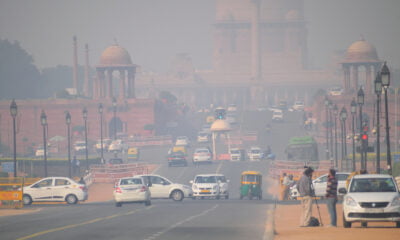

Economy
National contributions entry point for low-carbon transformation: Paris needs to build to below 2°C goal
Submitted national contributions to the new global climate agreement do not put the world on track to limit warming to 2 degrees Celsius. Implied is an acceleration and consolidation of action against climate change in major economies. Moreover, they serve as an entry point for the low-carbon transformation, if the Paris Agreement includes a mechanism to strengthen and broaden policy commitments by 2020 at the latest.
This is shown by a report published today by a consortium of 14 research institutes. The scientists and economists provide a detailed analysis of the energy sector transformations required to implement the intended nationally determined contributions (so called INDCs), in major economies and at the global level in aggregate, and their potential for keeping the below 2 degrees goal within reach.
The results show:
– What a deal in Paris will actually mean in practical terms through implementation of the plans. The report is global in focus, with particular emphasis on: the EU, US, China, India, Brazil, Japan and all INDCs up until India’s.
– How we will need to raise ambition regularly, starting soon after 2015, to keep the 2°C target in reach.
– Without this “ratcheting up”, getting back to a 2°C pathway post-2030 would also imply a sudden collapse of investments in fossil generation (hence massive stranded assets)and require a dramatic surge of investment in renewables.
– The need for a long-term goal in the Paris agreement to foster the development of national, long-term deep decarbonisation pathways by 2018.
“As of October 19, the 123 INDCs, covering 150 countries, submitted to the UNFCCC represent 86% of global GHG emissions in 2012. Such wide coverage, with countries from all continents, levels of development and historic positions in the climate negotiations is in itself a major step forward for climate action and a signal of commitment to the Paris negotiations”, says Teresa Ribera, project leader and Director of the Institute for Sustainable Development and International Relations (IDDRI).
“The criteria for judging INDCs is their capacity to unleash the deep decarbonisation of the energy sector by 2050. This report’s analysis shows that this transformation is emerging but not fast or deep enough. Future policies and targets must be defined to be coherent with deep decarbonisation by 2050, informed by concrete pathways to get there.”
The present analysis of INDCs was funded by the European Commission and conducted by leading research teams from Brazil, China, Japan, India, the United States and the European Union. By investigating the concrete implications of INDCs for the low-carbon transformation by and beyond 2030, from energy systems, buildings to transport and industry, it complements the upcoming cutting-edge assessments by UNFCCC and UNEP of the impact of INDCs on global emissions and the global temperature goal.
“While the climate pledges lay the foundation for a faster transition to a low-carbon economy worldwide, more is needed to bolster the commitment to the below 2 degrees goal”, explains Elmar Kriegler of the Potsdam Institute for Climate Impact Research. “The Paris Agreement should set a clear timeline for ramping up action. Mechanisms for strengthening INDCs by 2020 would send the required signal to investors in the energy sector and beyond, in particular through the announcement of further economy-wide climate policies.”
In the run-up to COP21, the report offers six key cross-cutting messages:
– The report shows that INDCs imply an acceleration and consolidation of action against climate change in major economies around the world.
– This is particularly true in the electricity sector, where INDCs will further drive the transition towards renewables and other low-emissions forms of electricity production. In the six major economies assessed individually, carbon dioxide emissions per unit of electricity production falls by about 40% between 2010 and 2030 and renewable electricity becomes the dominant source of electricity production at about 36% of the electricity mix. There are similar positive trends regarding energy efficiency, with the energy intensity of passenger transport, for example, falling by 30% in China, India, the EU, the US, Brazil, and Japan in aggregate.
– However, the report highlights that INDCs would imply uneven progress among the drivers of decarbonisation. Some crucial low-carbon solutions, like CCS, electric vehicles, advanced biofuels, sustainable urban planning, appear unlikely to be developed under the INDCs at the scale and speed required for a 2°C scenario. Likewise, the report highlights that INDCs would leave too much inefficient and unabated fossil fuel capacity online in 2030 to be coherent with a 2 degrees scenario. This highlights the risks of lock-in into a high carbon trajectory if action is not strengthened quickly.
– The INDCs need to be strengthened to keep the 2°C goal within reach. The INDCs alone, as currently proposed, would imply the need for a dramatic and abrupt shift of course in 2030 and a technically challenging and economically costly rate of transformation thereafter, if the 2°C goal is to be maintained.
– The Paris Agreement can build a bridge between INDCs and 2°C by establishing predictable and credible mechanism for regularly strengthening targets and policies, on a five yearly timeframe with the first strengthening taking place by 2020 at the latest. The report explores such a bridge scenario in which action is strengthened over time, beyond the level of ambition implied by the INDCs. In this scenario, a strengthening of policies and commitments by 2020 reduces emissions by more than 5 Gt CO2e in 2030 compared to the INDC level, allowing a less costly, more feasible trajectory towards 2°C. It also allows for a smoother reallocation of investment away from high-carbon towards low-carbon technologies and infrastructure, avoiding the risk of stranded assets and economic disruption.
Strengthening climate targets and policies will be aided by the fact that INDCs can lead to significant co-benefits to climate mitigation. For the countries studied, the report found significant reductions in energy dependency and local air pollution. “We found that the INDCs will also have benefits beyond climate mitigation—they will help countries to reduce local air pollution and curb growing energy imports in the EU, Japan and China,” says Jessica Jewell, researcher at the the International Institute for Applied Systems Analysis (IIASA). “Such co-benefits can be a significant opportunity to develop ambitious national climate policies, as they would further increase with strengthening the INDCs”, she adds.
Read the full report.


 Environment10 months ago
Environment10 months agoAre Polymer Banknotes: an Eco-Friendly Trend or a Groundswell?

 Environment12 months ago
Environment12 months agoEco-Friendly Home Improvements: Top 7 Upgrades for 2025

 Features9 months ago
Features9 months agoEco-Friendly Cryptocurrencies: Sustainable Investment Choices

 Features10 months ago
Features10 months agoEco-Friendly Crypto Traders Must Find the Right Exchange





























